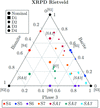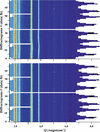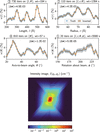issue contents
August 2022 issue

research papers
The vortex lattice phase diagram, order and transition kinetics in superconducting MgB2 doped with either manganese or carbon were studied using small-angle neutron scattering.
Open  access
access
 access
accessCharacteristics of irradiation-induced nanofeatures derived from magnetic small-angle neutron scattering are reported for low-dose neutron-irradiated Fe–(5–14)Cr–NiSiP model alloys and the reduced-activation ferritic/martensitic 9Cr steel Eurofer97.
Open  access
access
 access
accessMagnetic-field-dependent small-angle neutron scattering is employed to disclose the zero-field annealing-induced spin disorder around magnetic nanoprecipitates in an off-stoichiometric Ni50Mn45In5 Heusler alloy.
Effective removal of formaldehyde (HCHO) from solution at room temperature is highly desirable. This work provides a new strategy for the catalytic removal of HCHO by MnO2 at room temperature.
Open  access
access
 access
accessAn efficient neural network architecture to index Laue spots in synchrotron Laue microdiffraction patterns is presented. The efficiency and predictive capability of the model makes it applicable to real-time indexing of Laue microdiffraction data.
Open  access
access
 access
accessTwo-time correlation maps are classified in a simulation framework using an auto-encoder network.
Open  access
access
 access
accessA new model for the interpretation of small-angle neutron scattering data from aqueous foams is presented and validated using experimental data from a model foam system.
Open  access
access
 access
accessAn approach for optimal experimental design of neutron reflectivity experiments using metrics derived from the Fisher information is presented. This is demonstrated on a range of systems including lipid bilayers and magnetic heterostructures, and it is shown that small (or large) changes to the experimental setup can result in drastically reduced experimental count times.
The subtleties of generating random unit cells are discussed.
Open  access
access
 access
accessThe role that the transverse coherent extent of a neutron packet wavefunction plays in the analysis of specular neutron reflectivity is examined both theoretically and experimentally. It is shown how, in practice, the transverse coherent extent of an individual neutron packet wavefront can be measured and distinguished from the effects of geometrical angular divergence for a beam composed of a collection of such independent packets.
Download citation


Download citation


A combined inject-and-transfer system has been developed for sample delivery in serial femtosecond crystallography.
Open  access
access
 access
accessDifferent types of epitaxially grown microcrystals on Si are used for the demonstration of 3D reciprocal-space map reconstruction using the Radon transform. With this technique, high-resolution diffraction reciprocal-space maps in three dimensions can be collected efficiently even with a standard laboratory setup.
Open  access
access
 access
accessA case study on the use of both multivariate statistics and traditional methods for ill-conditioned powder samples (microabsorption and preferred orientation) using X-ray fluorescence and diffraction data is presented. Indications and recipes on how to exploit multivariate methods to limit and overcome the difficulties of real-world industrial samples and control the analytical error are given.
Download citation


Download citation


A variable-temperature synchrotron diffraction study shows that aluminium indium molybdate and aluminium indium tungstate undergo phase transitions from monoclinic to orthorhombic structures from the parent compounds at much lower temperatures than predicted by Vegard's law. In contrast to many orthorhombic A2M3O12 compositions, both compounds display positive thermal expansion.
Open  access
access
 access
accessIn the present work, electron backscatter diffraction is used to investigate the influence of crystal orientation and stress level on the dislocation structures generated during primary and steady-state creep in pure aluminium (99.8%). The goal is to characterize features of the microstructure with a statistically sound approach.
Open  access
access
 access
accessThis article reports the first successful operation of a neutron interferometer with a separate beam-recombining crystal. This result is a proof-of-principle demonstration showing that new-generation neutron interferometers and applications are possible.
The limitations of the general evaluation methods for microfibril orientation in ultra-high molecular weight polyethylene fibers are discussed, and an improved evaluation method is proposed.
Open  access
access
 access
accessA semi-supervised model to predict crystal structures from powder neutron diffraction patterns has been developed. The models have higher accuracies than current approaches while covering more space groups.
Download citation


Download citation


A powerful approach for total scattering data collection with a laboratory single-crystal diffractometer and data processing software has been developed, suitable for pair distribution function (PDF) analysis. The effectiveness of the approach was demonstrated with reference samples and real-case studies of tetranuclear lanthanide hydroxocarboxylates in solid form and in solution.
CCDC reference: 2165227
Wide- and small-angle X-ray scattering are used for an in situ study of the preoxidation of polyacrylonitrile fibers. The structural evolution characteristics of skeleton and pores in the fibers are described. Physical shrinkage and chemical shrinkage under heating occur successively.
Open  access
access
 access
accessCrack propagation in a silicon single-crystal wafer is tracked in situ using synchrotron-based ultra-high speed X-ray diffraction imaging. The high spatio-temporal resolution reached in diffraction imaging mode allows for assessing different parameters such as crack velocity or post crack movements of the separated wafers.
Open  access
access
 access
accessA systematic study was carried out to investigate the neutron transmission signal as a function of sample temperature. In particular, the experimentally determined wavelength-dependent neutron attenuation spectra for a martensitic steel at temperatures ranging from 21 to 700°C are compared with simulated data.
In this paper, a novel technique is proposed to retrieve the spectrum structure from reduced measurement energy points in spectroscopic ptychography, by utilization of the Kramers–Kronig relationship between absorption and phase contrasts. The spectral restoration of extended X-ray absorption fine structure by this algorithm is successfully demonstrated from both calculated model and spectroscopic ptychography experiment data.
Open  access
access
 access
accessA novel strategy is presented for sample jet alignment using machine vision for liquid-jet-based sample delivery systems. Feedback using height-resolution images from an optical microscope positioned perpendicular to the path of the X-ray beam enables tracking of the relative alignment of the liquid jet and X-ray beam.
Open  access
access
 access
accessQuantitative microstructural characterization of nanocrystalline materials based on Rietveld refinement of electron diffraction patterns has been used to explore sample characteristics. The electron microscope instrumental effects have been considered.
Open  access
access
 access
accessAn accurate and efficient method for model- and form-free inversion of a polydisperse small-angle scattering system is presented. It supports an arbitrary number of model parameters and both 1D and 2D intensity observations.
This paper presents a phase-retrieval algorithm for ptychography, named AMPAM. The imaging capability of AMPAM was investigated by numerical simulations and measurements performed at SPring-8.
Open  access
access
 access
accessThe Python extension CDEF is a suitable evaluation tool for experimentalists to calculate single-particle small-angle X-ray scattering profiles with satisfactory accuracy, as shown by comparison with common well-known analytical form factors. Using different complex cubic models, a direct comparison between CDEF and the already established SPONGE with respect to the size distribution of imperfect Au nanocubes showed a clear agreement of the results.
Open  access
access
 access
accessThe Skopi software package provides tools to generate realistic simulations of coherent X-ray diffractive imaging of noncrystalline biological samples, which in turn will aid algorithm development for a range of experiments at X-ray free-electron laser sources.
Open  access
access
 access
accessA Python 3 software package for precise calculation of X-ray structure factors of α-quartz over a wide temperature range is presented. α-Quartz was chosen because of its practical application in high-resolution X-ray spectroscopy, but this software package can be easily extended to other crystals.
short communications
Open  access
access
 access
accessTheoretical consideration and experimental demonstration reveal that the contrast variation in a birefringence image of an off-axis SiC wafer corresponds to the in-plane shear stress field.
computer programs
Open  access
access
 access
accessMoloVol is a free program for calculating volumes and surface areas of molecules and their cavities.
Open  access
access
 access
accessIn a world where data are steadily made more available, Gwaihir is a tool that overcomes multiple issues by bridging remote access, cluster computing and a user-friendly interface, consequentially improving the link between synchrotrons and their users for Bragg coherent diffraction imaging.
Open  access
access
 access
accessThe MATLAB-based software tool MuMag2022 is presented for the analysis of magnetic-field-dependent unpolarized small-angle neutron scattering data of bulk ferromagnets such as elemental nanocrystalline ferromagnets, magnetic nanocomposites or magnetic steels.
Open  access
access
 access
accessImprovements to the GenX program are discussed, including performance, model building and error analysis.

 journal menu
journal menu























































